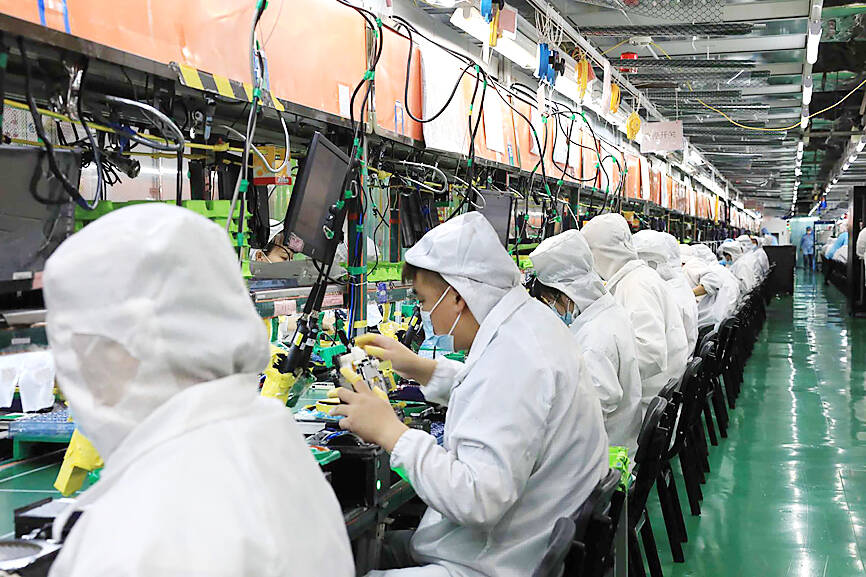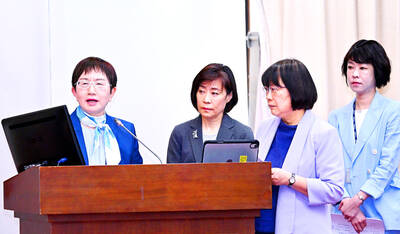Workers are departing Apple Inc’s biggest iPhone plant in China, seeking to escape hastily enforced COVID-19 measures that left many of the 200,000 staff grappling with inadequate living conditions.
Local authorities from several regions in Henan Province said they received workers from Foxconn Technology Group (富士康科技集團) after strict COVID-19 curbs were imposed at the plant in Zhengzhou to quell a COVID-19 outbreak, official posts online said.
At least six counties and cities in Henan asked residents who had just left Foxconn, known as Hon Hai Precision Industry Co (鴻海精密) in Taiwan, to contact local authorities before going home. Workers are to be sent to mandatory isolation for several days, official posts on Chinese messaging platform WeChat said.

Photo: China News Service via CNA
Cities such as Mengzhou and Luoyang have arranged buses to ferry workers to isolation sites for a seven-day compulsory isolation before allowing them to go home, the post said.
Videos and pictures of employees leaving the campus flooded social media over the weekend, showing local residents offering food and shelter to some of the departing staff.
“They were Foxconn employees who escaped from the factory and were walking home,” a WeChat user wrote in a post about the social media images.
“Some people were walking amid wheat fields with their luggage, blankets and quilts. I couldn’t help but feel sad,” the user added.
Tensions at the Zhengzhou plant underscore the economic and social costs of Chinese President Xi Jinping’s (習近平) “zero COVID-19” policy, a rigorously policed system of mass testing and lockdowns that has fostered growing resentment. It also shows the potential risk to global supply chains and products from China’s approach, which demands lockdowns, business restrictions and mass testing drives when even one COVID-19 case emerges.
Discontent has been brewing among staff at Foxconn’s main factory in Zhengzhou, where the emergence of COVID-19 cases saw it go into a closed-loop system. Closed loops enable companies to stay operational during lockdowns, but take a toll on workers, whose movements are severely limited, with some even required to sleep on factory floors.
Food has become a source of unrest after Foxconn shut cafeterias at the manufacturing site known as “iPhone City.” At one point, only workers on production lines were given meal boxes, with those infected or afraid to leave the company’s dormitories given more basic fare such as bread and instant noodles, Bloomberg News reported.
It is unclear how many workers were allowed to leave Foxconn. The company hires many temporary workers from nearby regions to assemble electronics, including Apple’s latest iPhone 14 devices. Foxconn and Apple did not immediately provide a comment outside of regular business hours.
Foxconn on Wednesday said that production had not been impacted by what it described as a “small” outbreak.
The discontent at the Zhengzhou plant comes at a crucial time for Apple, which launched the iPhone 14 during an unprecedented slump in global electronics demand. While faring better than other smartphone makers, it has backed off plans to increase production of its new iPhones this year after an anticipated surge in demand failed to materialize.
Apple reported better-than-expected results on Thursday, but warned of a holiday slowdown.
Any disruption at Zhengzhou threatens to snarl Apple’s finely orchestrated supply chain. Thousands of components from Europe to Asia are shipped into Zhengzhou, assembled manually into devices, then shuttled off to the rest of the world.
Over the past few days, photographs and video clips flooded social media sites such as Douyin and Weibo, purportedly taken by Foxconn workers dissatisfied with conditions in the plant.
One widely shared clip zeroed in on trash piled up outside dorm rooms, while another showed people jostling for food in an apartment complex, where workers were alleged to have been sent for quarantine. Others posted pleas for help.
Additional reporting by Reuters

‘SWASTICAR’: Tesla CEO Elon Musk’s close association with Donald Trump has prompted opponents to brand him a ‘Nazi’ and resulted in a dramatic drop in sales Demonstrators descended on Tesla Inc dealerships across the US, and in Europe and Canada on Saturday to protest company chief Elon Musk, who has amassed extraordinary power as a top adviser to US President Donald Trump. Waving signs with messages such as “Musk is stealing our money” and “Reclaim our country,” the protests largely took place peacefully following fiery episodes of vandalism on Tesla vehicles, dealerships and other facilities in recent weeks that US officials have denounced as terrorism. Hundreds rallied on Saturday outside the Tesla dealership in Manhattan. Some blasted Musk, the world’s richest man, while others demanded the shuttering of his

ADVERSARIES: The new list includes 11 entities in China and one in Taiwan, which is a local branch of Chinese cloud computing firm Inspur Group The US added dozens of entities to a trade blacklist on Tuesday, the US Department of Commerce said, in part to disrupt Beijing’s artificial intelligence (AI) and advanced computing capabilities. The action affects 80 entities from countries including China, the United Arab Emirates and Iran, with the commerce department citing their “activities contrary to US national security and foreign policy.” Those added to the “entity list” are restricted from obtaining US items and technologies without government authorization. “We will not allow adversaries to exploit American technology to bolster their own militaries and threaten American lives,” US Secretary of Commerce Howard Lutnick said. The entities

Minister of Finance Chuang Tsui-yun (莊翠雲) yesterday told lawmakers that she “would not speculate,” but a “response plan” has been prepared in case Taiwan is targeted by US President Donald Trump’s reciprocal tariffs, which are to be announced on Wednesday next week. The Trump administration, including US Secretary of the Treasury Scott Bessent, has said that much of the proposed reciprocal tariffs would focus on the 15 countries that have the highest trade surpluses with the US. Bessent has referred to those countries as the “dirty 15,” but has not named them. Last year, Taiwan’s US$73.9 billion trade surplus with the US

Prices of gasoline and diesel products at domestic gas stations are to fall NT$0.2 and NT$0.1 per liter respectively this week, even though international crude oil prices rose last week, CPC Corp, Taiwan (台灣中油) and Formosa Petrochemical Corp (台塑石化) said yesterday. International crude oil prices continued rising last week, as the US Energy Information Administration reported a larger-than-expected drop in US commercial crude oil inventories, CPC said in a statement. Based on the company’s floating oil price formula, the cost of crude oil rose 2.38 percent last week from a week earlier, it said. News that US President Donald Trump plans a “secondary